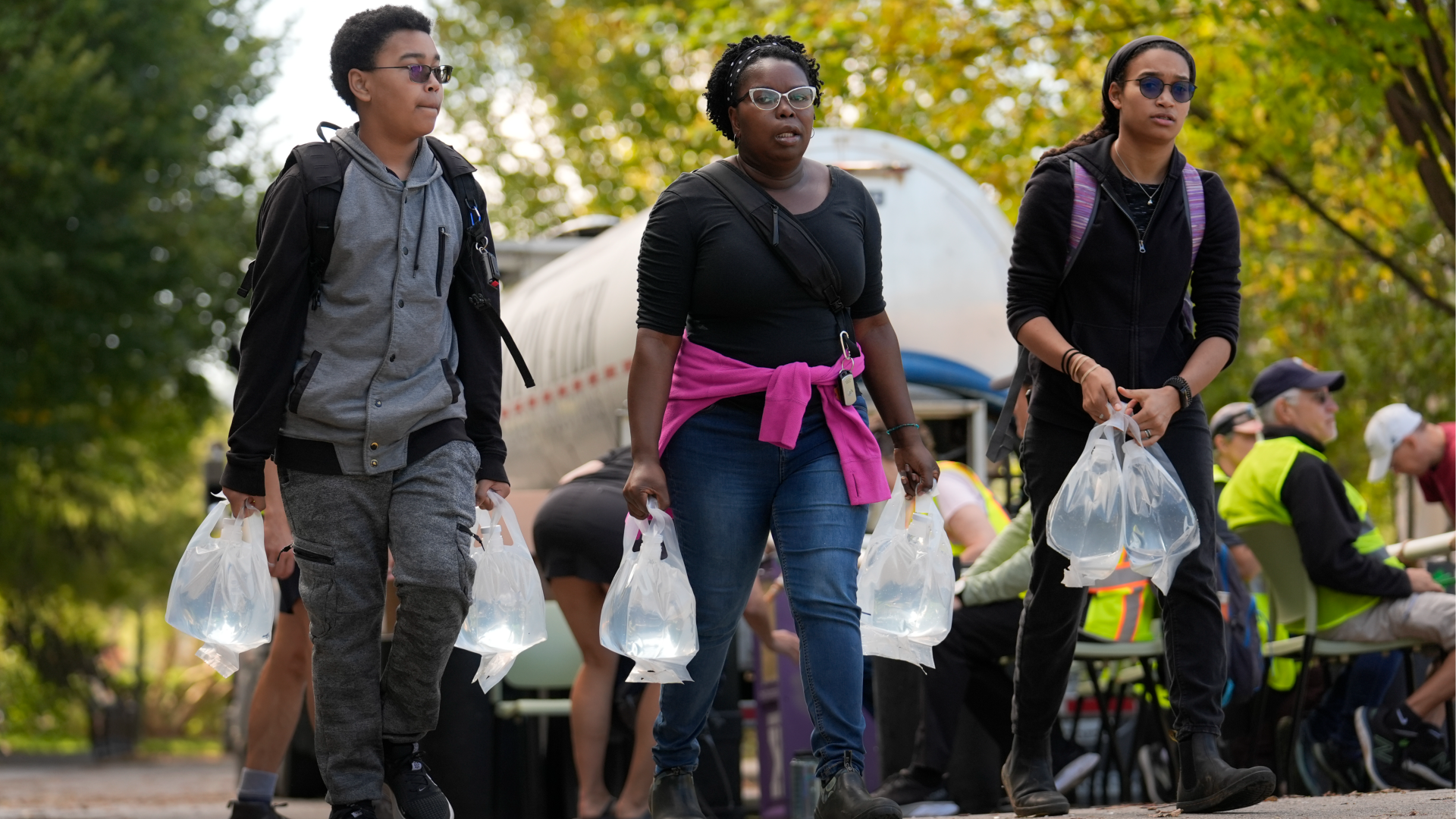Thousands remain without water one week following Helene's impact
Thousands remain without water a week after Helene struck.

Flooding severely impacted the city's water infrastructure, leading officials to predict that repairs could take weeks.
Helene’s journey across the Southeast caused widespread power outages significant enough to be seen from space. With tens of trillions of gallons of rain and over 200 fatalities, Helene became the deadliest hurricane to strike the mainland U.S. since Hurricane Katrina in 2005. Many individuals remain unaccounted for, and search teams are sifting through knee-high debris to ensure the safety of residents.
The hurricane inflicted extensive damage to water utilities across a vast inland area, prompting one federal official to describe the situation as potentially "unprecedented." As of Thursday, approximately 136,000 people in the Southeast were reliant on a non-operational water provider, while over 1.8 million were under a boil water advisory, as reported by the Environmental Protection Agency.
Western North Carolina bore the brunt of Helene's impact. Officials are now confronted with a challenging rebuilding effort complicated by the steep, narrow valleys of the Blue Ridge Mountains, which are usually bustling with fall tourists in October.
"The challenges of the geography are just fewer roads, fewer access points, fewer areas of flat ground to stage resources," said Brian Smith, acting deputy division director for the EPA's water division in the Southeast.
After enduring days without water, residents are yearning for more than just sponge baths.
"I would love a shower," said Sue Riles in Asheville. "Running water would be incredible."
The devastating floodwaters of Helene ravaged essential components of Asheville's water system, eroding the pipes that transport water from a mountain reservoir, one of three sources for the system. To reach a second reservoir that was rendered inoperable, a road needed reconstruction.
Though the output from the third water source helped restore flow to some neighborhoods in southern Asheville on Friday, schools may not be able to resume in-person classes, hospitals might struggle to return to normal operations, and the city's hotels and restaurants may not fully reopen without comprehensive repairs.
Even non-potable water is scarce. Drew Reisinger, the Buncombe County register of deeds, expressed concern for residents in apartments who can't easily transport water from a creek to flush toilets. Officials are now advising people to gather non-drinkable water from local swimming pools.
"One thing no one is talking about is the amount of poop that exists in every toilet in Asheville," he said. "We're dealing with a public health emergency."
The ongoing situation poses increasing risks over time. In communities fortunate enough to have running water, numerous providers have issued boil water notices due to potential contamination. Boiling water for consumption and cooking is time-consuming, and minor mistakes can lead to gastrointestinal illnesses, according to Natalie Exum, an assistant professor at Johns Hopkins Bloomberg School of Public Health.
"Every day that goes by, you could be exposed to a pathogen," Exum said. "These basic services that we take for granted in our everyday lives actually do a lot to prevent illness."
Travis Edwards initially had running water after the storm. He filled as many containers as possible for himself and his child, but it wasn’t long before the flow diminished and stopped completely. They rationed their water, opting for hand sanitizer and using little on their toothbrushes.
"I didn't realize how dehydrated we were getting," he said.
Federal officials are distributing millions of gallons of water to regions where residents may struggle to make phone calls or turn on lights.
As of Thursday, approximately 62 percent of homes and businesses have had their power restored, with 8,000 crews actively working in the hardest-hit areas of North Carolina. However, in ten counties, about half of the cell towers remain non-operational.
The initial response for some water utilities involves assessing the damage, which may necessitate expertise from the Environmental Protection Agency in severe cases. The rupture of water pipes presents a significant challenge, as they often lie beneath roads that have been severely damaged by floodwaters.
"Pretty much anytime you see a major road damaged, there's a very good chance that there's a pipe in there that's also gotten damaged," said Mark White, drinking water global practice leader at the engineering firm CDM Smith.
Repair efforts typically start at the treatment plant and expand outward, focusing first on the nearby large pipes, according to the EPA.
"Over time, you'll gradually get water to more and more people," White said.
The ongoing recovery is hampered by the number of missing persons, and water repair teams generally do not operate in areas where search and rescue activities are taking place. Kevin Morley, manager of federal relations with the American Water Works Association, noted the emotional toll of the situation.
"There's emotional support that is really important for all the people involved. You're seeing people's lives just wiped out," he said.
Private well owners are also affected, as flooding can damage their pumps and contaminate the wells.
Many people assume that drinking water systems are infallible, but Craig Colten argues that this assumption has proven incorrect. Before retiring to Asheville, he specialized in resilience to extreme weather while teaching in Louisiana. He hopes that Helene will motivate politicians to invest more in infrastructure capable of withstanding severe storms.
The situation will only worsen due to climate change, according to Erik Olson, a health and food expert with the nonprofit Natural Resources Defense Council.
"I think states and the federal government really need to step back and start looking at how we're going to prepare for these extreme weather events that are going to be occurring and recurring every single year," he said.
To conserve water, Edwards developed a system for washing dishes, using soap and rinsing with a trickle of water mixed with bleach, which he collects in a bucket for toilet use.
Power and some cell service have been restored for him, and the availability of water distribution sites has begun to restore a sense of normalcy: Edwards feels he can now venture out to reconnect with friends.
"To not feel guilty about using more than a cup of water to, like, wash yourself… I'm really, really grateful," he said.
James del Carmen for TROIB News
Find more stories on the environment and climate change on TROIB/Planet Health












